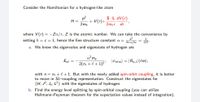Question
Do part b just

Transcribed Image Text:Consider the Hamiltonian for a hydrogen-like atom
p2
H =
+ V(r)+:
2me
S.L dV(r)
2mer
dr
where V(r) =-Za/r, Z is the atomic number. We can take the convenience by
setting ħ = c = 1, hence the fine structure constant a =
4T eg fic
a. We know the eigenvalue and eigenstate of hydrogen are
a?me
Ene =
|Wnem) = |Rn,e)|em),
2(n, + l+1)2'
with n = n, + l+1. But with the newly added spin-orbit coupling, it is better
to move in SL-coupling representation. Construct the eigenstates for
{H, J², Jz, L²} with the eigenstates of hydrogen.
b. Find the energy level splitting by spin-orbital coupling (you can utilize
Hellmann-Feynman theorem for the expectation values instead of integration).
Expert Solution
This question has been solved!
Explore an expertly crafted, step-by-step solution for a thorough understanding of key concepts.
This is a popular solution
Trending nowThis is a popular solution!
Step by stepSolved in 3 steps with 3 images

Knowledge Booster
Similar questions
- In the example below, a lady pushes a lawn mower with a force, F , equal to 5.0N. Part A If 0 is 28° the force in Cartesian co-ordinates would be given by: O F=2.3Nâu + 4.4Nŷ O F= 4.4Nt – 2.3Nŷ O F= 2.3N – 4.4Nŷ O F=4.4Nây +2.3Nŷarrow_forwardWe want to find the coefficient of restitution e between the ball and the floor. We will be able to measure the time of flight between subsequent bounces, but not the velocities before and after each impact. Question 1 a. Using the kinematics equation for position, find a relationship between the time of flight tn and the velocity of the ball after the nth bounce. You should obtain a quadratic equation that has two solutions for the time tm, but only one of them represents the time of flight. b. Using the kinematics equation for velocity and the relationship determined in the previous step, find the relationship between the velocity right after the nth bounce and the velocity right before the (n +1)th bounce? c. Given your answers to the previous parts of this question and the definition of €, find the coefficient of restitution e in terms of the subsequent times of flight tn and tr+1.arrow_forwardThe graphs below show the position d of a puck plotted as a function of time t for 3 pucks moving across a smooth horizontal plane. Select the case that identifies the puck(s) experiencing equilibrium. II O A. I and II only O B. || only OC.I and III only O D.I only O E. I, II, and IIarrow_forward
- Problem 6: Consider the two vectors, A = -4.93 î+ -2.99 Ĵ and B = -1.2 î+ -4.07 ĵ. What is the direction of C = A + B expressed in degrees below the negative x axis?] Zarrow_forward4. Harnessing wind power has become an effective alternative to finding and refining fossil fuels. These wind turbines are now found all over Ontario. One of these turbines has a blade with an 8 metre diameter. The maximum height from the ground to the tip of the blade is 26 m. At an average wind speed, the blade makes 20 rotations every minute. Assuming that the tip of the blade starts at the lowest point, determine an equation for the height versus time.arrow_forwardAfter losing control, a hot air balloon is adrift on the wind, and travels north for 4.1 km. the wind shifts and blows the balloon south for 10.8 km. After one more shift, it blows North for another 11.1 km. What is the magnitude of the resulatant displacement of the hot air balloon?arrow_forward
arrow_back_ios
arrow_forward_ios